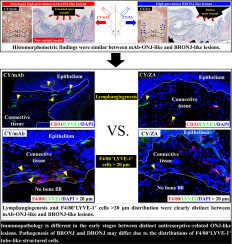Our official English website, www.x-mol.net, welcomes your feedback! (Note: you will need to create a separate account there.)
Distinct immunopathology in the early stages between different antiresorptives-related osteonecrosis of the jaw-like lesions in mice
Bone ( IF 4.1 ) Pub Date : 2020-06-01 , DOI: 10.1016/j.bone.2020.115308 Hiroki Hayano 1 , Shinichiro Kuroshima 1 , Muneteru Sasaki 1 , Saki Tamaki 1 , Maaya Inoue 1 , Akira Ishisaki 2 , Takashi Sawase 1
Bone ( IF 4.1 ) Pub Date : 2020-06-01 , DOI: 10.1016/j.bone.2020.115308 Hiroki Hayano 1 , Shinichiro Kuroshima 1 , Muneteru Sasaki 1 , Saki Tamaki 1 , Maaya Inoue 1 , Akira Ishisaki 2 , Takashi Sawase 1
Affiliation

|
There is limited information about denosumab-related osteonecrosis of the jaw (DRONJ), unlike bisphosphonate-related ONJ (BRONJ). The mode of action is clearly different between denosumab and bisphosphonates. DRONJ occurs mainly following tooth extraction in cancer patients treated with the combination of denosumab and other drugs including chemotherapy. However, DRONJ animal models similar to these clinical situations have not been developed. The aims of this study were to 1) create a new model of high-prevalence chemotherapy/anti-RANKL antibody-related ONJ-like lesions to mimic patients receiving a high-dose denosumab/chemotherapy combination; and 2) compare the histopathological and immunopathological findings in the early stages of BRONJ-like and anti-RANKL antibody-related ONJ-like lesions. Cyclophosphamide (CY) and anti-mouse RANKL monoclonal antibody (mAb) or zoledronate combination therapy (CY/mAb and CY/ZA, respectively) was performed to create ONJ-like lesions in female C57BL/6J mice. Both maxillary first molars were extracted at 3 weeks after drug administration. The animals were euthanized at either 2 or 4 weeks after tooth extraction. Increased necrotic bone and empty lacunae with decreased living bone and osteocyte numbers were common histopathological findings in CY/mAb- and CY/ZA-induced impaired wound healing at 4 weeks after tooth extraction, and they were diagnosed as ONJ-like lesions based on validation of BRONJ and DRONJ in humans. In areas of impaired healing at 2 weeks post-extraction, decreases in angiogenesis and F4/80+LYVE-1- macrophages were noted as common immunopathological findings, although anti-angiogenesis was worse with CY/mAb than with CY/ZA. Interestingly, CY/mAb did not reduce F4/80+LYVE-1+ cells and normal lymphangiogenesis remained, whereas CY/ZA profoundly suppressed the larger size of F4/80+LYVE-1+ cells, similar to vessels with a concomitant decrease in lymphangiogenesis. Therefore, the distribution of the larger size of F4/80+LYVE-1+ cells differed in the early stages between different antiresorptive-induced ONJ-like lesions in conjunction with lymphangiogenesis, although the histopathological findings were similar. These findings suggest that the pathogenesis of BRONJ and DRONJ may differ due to the distributions of F4/80+LYVE-1+ tube-like-structured cells.
中文翻译:

小鼠颌骨样病变不同抗吸收药物相关性骨坏死的早期免疫病理学不同
与双膦酸盐相关的 ONJ (BRONJ) 不同,关于狄诺塞麦相关的颌骨坏死 (DRONJ) 的信息有限。地诺单抗和双膦酸盐的作用方式明显不同。DRONJ 主要发生在接受狄诺塞麦和其他药物(包括化疗)联合治疗的癌症患者拔牙后。然而,尚未开发出与这些临床情况类似的 DRONJ 动物模型。本研究的目的是 1)创建一个新的高流行化疗/抗 RANKL 抗体相关 ONJ 样病变模型,以模拟接受高剂量地诺单抗/化疗组合的患者;2) 比较 BRONJ 样和抗 RANKL 抗体相关 ONJ 样病变早期的组织病理学和免疫病理学结果。进行环磷酰胺 (CY) 和抗小鼠 RANKL 单克隆抗体 (mAb) 或唑来膦酸联合治疗(分别为 CY/mAb 和 CY/ZA)以在雌性 C57BL/6J 小鼠中产生 ONJ 样病变。给药后3周拔除上颌第一磨牙。在拔牙后 2 或 4 周对动物实施安乐死。拔牙后 4 周 CY/mAb 和 CY/ZA 诱导的伤口愈合受损中,坏死骨增加和空洞增加,活骨和骨细胞数量减少是常见的组织病理学发现,根据验证,它们被诊断为 ONJ 样病变人类中的 BRONJ 和 DRONJ。在拔牙后 2 周愈合受损的区域,血管生成和 F4/80+LYVE-1-巨噬细胞减少是常见的免疫病理学发现,尽管 CY/mAb 的抗血管生成效果比 CY/ZA 差。有趣的是,CY/mAb 并没有减少 F4/80+LYVE-1+ 细胞和正常的淋巴管生成,而 CY/ZA 显着抑制了更大尺寸的 F4/80+LYVE-1+ 细胞,类似于伴随减少的血管淋巴管生成。因此,尽管组织病理学结果相似,但早期不同抗再吸收诱导的 ONJ 样病变与淋巴管生成的较大尺寸的 F4/80+LYVE-1+ 细胞的分布不同。这些发现表明,由于 F4/80+LYVE-1+ 管状结构细胞的分布,BRONJ 和 DRONJ 的发病机制可能不同。而 CY/ZA 显着抑制了较大尺寸的 F4/80+LYVE-1+ 细胞,类似于伴随淋巴管生成减少的血管。因此,尽管组织病理学结果相似,但早期不同抗再吸收诱导的 ONJ 样病变与淋巴管生成的较大尺寸的 F4/80+LYVE-1+ 细胞的分布不同。这些发现表明,由于 F4/80+LYVE-1+ 管状结构细胞的分布,BRONJ 和 DRONJ 的发病机制可能不同。而 CY/ZA 显着抑制了较大尺寸的 F4/80+LYVE-1+ 细胞,类似于伴随淋巴管生成减少的血管。因此,尽管组织病理学结果相似,但早期不同抗再吸收诱导的 ONJ 样病变与淋巴管生成的较大尺寸的 F4/80+LYVE-1+ 细胞的分布不同。这些发现表明,由于 F4/80+LYVE-1+ 管状结构细胞的分布,BRONJ 和 DRONJ 的发病机制可能不同。尽管组织病理学结果相似。这些发现表明,由于 F4/80+LYVE-1+ 管状结构细胞的分布,BRONJ 和 DRONJ 的发病机制可能不同。尽管组织病理学结果相似。这些发现表明,由于 F4/80+LYVE-1+ 管状结构细胞的分布,BRONJ 和 DRONJ 的发病机制可能不同。
更新日期:2020-06-01
中文翻译:

小鼠颌骨样病变不同抗吸收药物相关性骨坏死的早期免疫病理学不同
与双膦酸盐相关的 ONJ (BRONJ) 不同,关于狄诺塞麦相关的颌骨坏死 (DRONJ) 的信息有限。地诺单抗和双膦酸盐的作用方式明显不同。DRONJ 主要发生在接受狄诺塞麦和其他药物(包括化疗)联合治疗的癌症患者拔牙后。然而,尚未开发出与这些临床情况类似的 DRONJ 动物模型。本研究的目的是 1)创建一个新的高流行化疗/抗 RANKL 抗体相关 ONJ 样病变模型,以模拟接受高剂量地诺单抗/化疗组合的患者;2) 比较 BRONJ 样和抗 RANKL 抗体相关 ONJ 样病变早期的组织病理学和免疫病理学结果。进行环磷酰胺 (CY) 和抗小鼠 RANKL 单克隆抗体 (mAb) 或唑来膦酸联合治疗(分别为 CY/mAb 和 CY/ZA)以在雌性 C57BL/6J 小鼠中产生 ONJ 样病变。给药后3周拔除上颌第一磨牙。在拔牙后 2 或 4 周对动物实施安乐死。拔牙后 4 周 CY/mAb 和 CY/ZA 诱导的伤口愈合受损中,坏死骨增加和空洞增加,活骨和骨细胞数量减少是常见的组织病理学发现,根据验证,它们被诊断为 ONJ 样病变人类中的 BRONJ 和 DRONJ。在拔牙后 2 周愈合受损的区域,血管生成和 F4/80+LYVE-1-巨噬细胞减少是常见的免疫病理学发现,尽管 CY/mAb 的抗血管生成效果比 CY/ZA 差。有趣的是,CY/mAb 并没有减少 F4/80+LYVE-1+ 细胞和正常的淋巴管生成,而 CY/ZA 显着抑制了更大尺寸的 F4/80+LYVE-1+ 细胞,类似于伴随减少的血管淋巴管生成。因此,尽管组织病理学结果相似,但早期不同抗再吸收诱导的 ONJ 样病变与淋巴管生成的较大尺寸的 F4/80+LYVE-1+ 细胞的分布不同。这些发现表明,由于 F4/80+LYVE-1+ 管状结构细胞的分布,BRONJ 和 DRONJ 的发病机制可能不同。而 CY/ZA 显着抑制了较大尺寸的 F4/80+LYVE-1+ 细胞,类似于伴随淋巴管生成减少的血管。因此,尽管组织病理学结果相似,但早期不同抗再吸收诱导的 ONJ 样病变与淋巴管生成的较大尺寸的 F4/80+LYVE-1+ 细胞的分布不同。这些发现表明,由于 F4/80+LYVE-1+ 管状结构细胞的分布,BRONJ 和 DRONJ 的发病机制可能不同。而 CY/ZA 显着抑制了较大尺寸的 F4/80+LYVE-1+ 细胞,类似于伴随淋巴管生成减少的血管。因此,尽管组织病理学结果相似,但早期不同抗再吸收诱导的 ONJ 样病变与淋巴管生成的较大尺寸的 F4/80+LYVE-1+ 细胞的分布不同。这些发现表明,由于 F4/80+LYVE-1+ 管状结构细胞的分布,BRONJ 和 DRONJ 的发病机制可能不同。尽管组织病理学结果相似。这些发现表明,由于 F4/80+LYVE-1+ 管状结构细胞的分布,BRONJ 和 DRONJ 的发病机制可能不同。尽管组织病理学结果相似。这些发现表明,由于 F4/80+LYVE-1+ 管状结构细胞的分布,BRONJ 和 DRONJ 的发病机制可能不同。


























 京公网安备 11010802027423号
京公网安备 11010802027423号